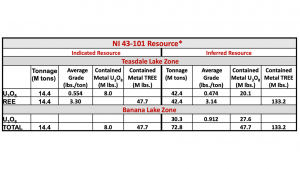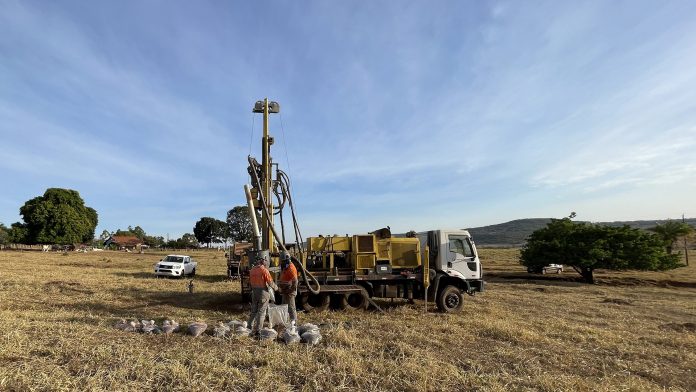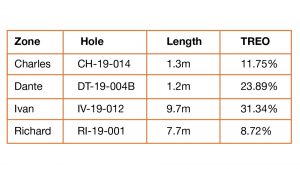Through the development and employment of its new projects, Appia is expanding and advancing the quality of rare earth projects in friendly jurisdictions to answer the global demand for rare earths.
In a world that is increasingly looking to rare earths and uranium to fuel the future, Appia Rare Earths & Uranium Corporation is currently developing three cornerstone rare earth projects in mining-friendly jurisdictions. It recently added a large and underexplored ionic clay rare earths deposit in Brazil to a portfolio that already includes the Alces Lake Project in Saskatchewan’s Athabasca Basin – one of the highest-grade rare earth prospects in the world.
Other properties in Appia’s portfolio include its Elliot Lake Property in Ontario’s historic mining camp, with a large NI 43-101 uranium and rare earths resource. Fully funded with over C$5m in cash, no debt, aggressive exploration currently underway, and experienced management, Appia is progressing rapidly on multiple fronts in highly desired market sectors.
Brazil: The PCH Rare Earths Ionic Clay Project
In June 2023, Appia entered into an agreement to acquire a 70% interest in the Cachoeirinha Rare Earths Ionic Clay Project (PCH Project) in Brazil. Brazil is emerging as a leader in rare earth projects and critical minerals exploration, particularly for companies looking for new opportunities to develop large, low-cost projects to feed the growing needs of western supply chains.
The PCH Rare Earths Ionic Clay Project is a 17,551 hectare property located in the Tocantins Structural Province of the Brasília Fold Belt in Brazil, containing both heavy and light critical rare earths. It is approximately 30km from Iporá – a city with a population of about 31,500, in the state of Goiás. The region around Iporá has significant mineral exploration and mining activity, as well as developed infrastructure. The PCH property surrounds tenements held by Vale and Dundee Precious Metals in the central area of the tenement package, and tenements held by Atlas Litio in the northwest. Located in a mining-friendly region with excellent infrastructure support, the PCH Project benefits from its strategic location, and the local community has demonstrated strong support for the project.
The PCH Project is a rare earth element-carbonatite alkaline complex exhibiting highly anomalous REE and niobium mineralisation combined with distinctive ionic clay development. This mineralisation is related to alkaline lithologies of the Fazenda Buriti Plutonic Complex and the hydrothermal and surface alteration products of this complex, by supergene enrichment in a tropical climate. The rare earth mineralisation at PCH is primarily a result of the intensive weathering of granites, which leads to the formation of ionic clay deposits. Results of the recent geochemical exploration work carried out to date indicates the presence of REEs and niobium within lateritic ionic adsorption clays.
Sampling data highlights the enrichment of rare earth minerals from as shallow as 2m up to 20m in depth. The known mineralisation is widespread across the nine known rare earth project areas at the PCH property, with a primary focus on a significant target known as Target 4 in the southwest corner of the tenements. Exploration work previously conducted and confirmed by Appia’s extensive due diligence revealed enrichments of rare earth elements (REEs), with depths ranging from 8-26m with the majority found in the upper 8-10m.
The auger holes drilled at Target 4 have exhibited a range of total REE grades, ranging from 274ppm to 16,648ppm (1.66%), with an average of 1,291ppm total REE. The valuable rare earths used in magnet applications – praseodymium, neodymium, terbium, dysprosium and yttrium (Pr, Nd, Tb, Dy, and Y) – accounted for approximately 14% of total rare earths, reaching a maximum of 28.4%. Notably, the deposit also contains anomalous values of niobium and scandium, with average values of 736ppm for Nb and 62ppm for scandium in a composite sample from Target 4.
Heavy rare earth elements (HREEs) show maximum values of 1,624ppm and average values of 1,291ppm, primarily as terbium and dysprosium. Light rare earths (LREEs) show maximum values of 14,024ppm (1.54%) with an average of 1.145ppm. Neodymium and praseodymium, the main magnetic light rare earths, show respective maximum values of 3,131ppm (Nd) and 885ppm (Pr) and average values of 216ppm (Nd) and 61.7ppm (Pr). The overall HRRE/LREE ratio has a maximum of 39.5% and an average value of 16.67%.
Appia’s PCH rare earth project is located on the same Brasilia Fold Belt as the Serra Verde rare earth project. Professional Geoscientist Don Hains, an expert in industrial minerals and Appia’s Qualified Person for the PCH Project, said: “The average HREE value at PCH is 145ppm, or 13.93% of the total rare earths.
“In contrast, the Serra Verde project, currently under construction in northern Goais State, has total average REE values of 2,138ppm (0.2138%) but HREE values of only 155ppm, or 7.26% of total rare earths. Thus, the PCH project has a relatively higher content of heavy rare earth elements in the deposit than Serra Verde.”
Equally as important, both deposits have essentially the same percentage – about 23% – of the more valuable rare earth elements Pr, Nd, Dy and Tb relative to total rare earth content.
Diamond and auger drilling, trenching, stream sediment sampling, and various geophysical testing methods on Target 4 have returned values, particularly for the highly valuable heavy rare earths terbium and dysprosium, that surpass known ionic clay deposits in Brazil including Serra Verde.
Discovery diamond drill hole PCH-F01 drilled by the vendors revealed robust mineralisation starting from the surface and extending through the length of the entire hole. The mineralisation remains open at depth, presenting a compelling opportunity for expansion through additional exploration efforts. Field observation of hole PCH-F01 has shown the presence of continuous mineralisation beneath the conventional ionic clay mineralisation. This suggests the existence of a mineralised zone that holds the potential to explore not only high-grade ionic clay horizons but also to add tonnage through carbonatite alkali and hydrothermal breccias mineralised rocks. Assay results from drill hole PCH-F01 are expected to be reported in September.
Preliminary metallurgical test work has been conducted at renowned institutions such as Actlabs and SGS Mineral Services in Canada, alongside geometallurgical and flotation test work at the Federal University of Goiás. Successful floatation of La, Nd, and Nb was achieved in testing, with La and Nd recoveries averaging around 50% for the best collector conditions without any initial processing.
Don Hains said in the company’s 20 June, 2023 press release: “Flotation concentrates averaged 127ppm Th and 38ppm U, indicating radioactivity issues associated with mineral processing should be very manageable.”
In July 2023, Appia began an aggressive auger and reverse circulation drill campaign on Target 4 with the purpose of expanding the known zone of mineralisation and as a step toward eventually delineating a resource estimate. The drilling of a planned 300 new holes is underway across the Target 4 area, along with a Light Detection and Ranging (LiDAR) topographic survey covering approximately 1,700 hecatres, across the southern, western, and northwestern extensions of Target 4.
Appia’s management and geological team believe the PCH Project’s combination of ionic clay development and primary rare earth mineralisation presents an exceptional opportunity in the increasingly important critical minerals sector, with further expansion potential across the largely underexplored 17,551-hectare property.
Alces Lake: One of the highest-grade rare earth deposits in the world
The Alces Lake rare earths oxides (REO) geochemical assay results rank as the highest-grade REE occurrences in Canada. Results to date have returned world-class REO grades comparable to those encountered in: the historic REE producing Steenkampskraal, South Africa; the deposits of the Mountain Pass, USA; the currently producing Gakara project, Burundi, and Lynas Corp.’s Mount Weld CLD mine, Australia.
The Alces Lake property is located north of Lake Athabasca and the Athabasca Basin in northern Saskatchewan, approximately 34km east of Uranium City and 135km west of Stony Rapids. The Athabasca Basin is well-known as the ‘most attractive jurisdiction in Canada’ for mining exploration and development. Nearby Uranium City has a certified airport, hydroelectric power, bulk fuel dispensary, a fleet of heavy-duty construction equipment, and telephone and internet communications.
The Alces Lake rare earth project extensively displays both high-grade and low-to-medium-grade monazite mineralisation with surface and near-surface showings of medium-to-coarse-grained monazite found intermittently over 27km2. It has multiple zones of REE discoveries along geological strike, on sub-parallel trends and with sub-surface zones open in all directions. Metallurgical testing to date confirms simple mineralogy and processing potential, similar to other producing mines.
Over 12 high-grade REE zones have been identified to date across the property, with surface and near-surface monazite occurrences that remain open at depth and along strike. REE mineralisation is enriched with critical REEs (Nd, Pr, Dy, Tb) used for permanent magnets. Drill and geochemical assay results from the 2022 exploration programme, which saw 17,481m drilled, returned highly-mineralised intervals from new sections in the Alces Lake’s Wilson Zone and doubled the strike length of the newly-identified underlying AMP Zone to 300m, which remains open down plunge and along strike. In 2022, a total of 37 holes were drilled into the WRCB Zone to continue delineation of the high-grade REE mineralisation and the deeper AMP Zone. Drilling also focused on delineating previously undrilled targets in the Danny Zone, as well as 34 holes (5,318m) drilled into the primary Magnet Ridge target that outcrops on surface.
Drilling has produced some very high-grade intersections of total rare earth oxide (TREO). Some of the higher TREO results include:
Mineralisation from all areas explored to date show anomalously high concentrations of REEs with Nd, Pr, Dy and Tb accounting for 24% of the TREO content (Source: NI 43-101 Report, 30 May, 2023).
Bench-scale monazite processing and metallurgical testing results have been comparable to other producing rare earth projects. Preliminary work done at the Saskatchewan Research Council achieved flotation concentrate TREO of 48% with 73% TREO recovery. Improvements are expected from future testing. The Saskatchewan Research Council is currently building a monazite processing facility in the province and will be looking to secure local feedstock.
In early June 2023, Appia began a fully-funded $3m exploration programme at Alces Lake, focused on determining high priority drill targets along the mineralised structural corridor leading SSE from the Magnet Ridge zone for over 20km. The five-phase programme is based on 2022 drilling results and includes an aggressive prospecting and sampling programme, followed up by selective drilling of priority targets, and airborne gravity-magnetics-radiometrics at 100m line spacing on two of the identified high priority areas on the property, namely the eastern structural corridor and Alces Lake North.

Elliott Lake Uranium & Rare Earth Project
Appia also has a 100% interest in its Elliot Lake property in northern Ontario, Canada, totalling approximately 13,008 hectares (32,143 acres) in size. The property is approximately 3km north of the town of Elliot Lake and is adjacent to Denison Mines Corp. and Rio Algom Limited, both past-producing uranium and REE mines. The Elliot Lake area has produced over 300 million pounds of triuranium octoxide (U3O8) and is the only mining camp in Canada with significant historical commercial rare earth element production, namely yttrium.
Two zones at the Elliott Lake property – Teasdale Lake Zone and Banana Lake Zone – have NI 43-101 Mineral Resources of U308 and rare earth elements:
The resource areas at the Elliot Lake property are largely unconstrained along strike and down dip, providing significant potential to increase the size of the current resources.
At the Elliott Lake rare earth project, the uranium and REE metals are hosted within quartz-pebble conglomerate beds that are found in the Matinenda Formation, which is the basal unit of the Elliot Lake Group. The uranium and REE-bearing horizon is a clean, well-sorted, coarse-pebble conglomerate. Metallurgical testing, using different process methods, indicates a recovery rate of approximately 90% for uranium and most REEs in the 80-90% range.
Appia: Advancing quality rare earth projects in friendly jurisdictions
With the addition of its new ionic clay PCH Rare Earths Project in Brazil, Appia has created an impressive portfolio of rare earth projects in mining-friendly jurisdictions. Both the Brazilian PCH ionic clay project and the Alces Lake project in Saskatchewan have already returned impressive rare earth results and remain open for further discoveries and development.
With dedicated management and a fully-funded exploration war chest, Appia is moving forward quickly with aggressive and fully-funded exploration programmes for both projects in 2023, which should gain the attention of both investors and a world hungry for access to high-quality and reliable rare earth projects.
Please note, this article will also appear in the fifteenth edition of our quarterly publication.










